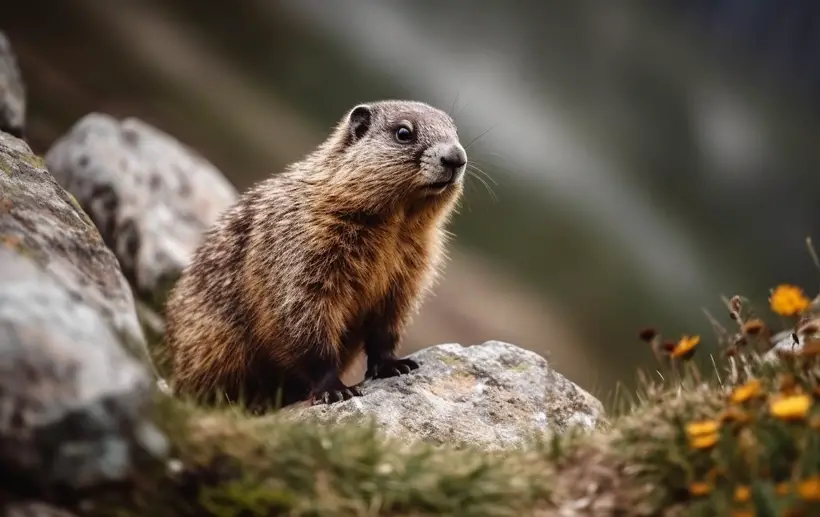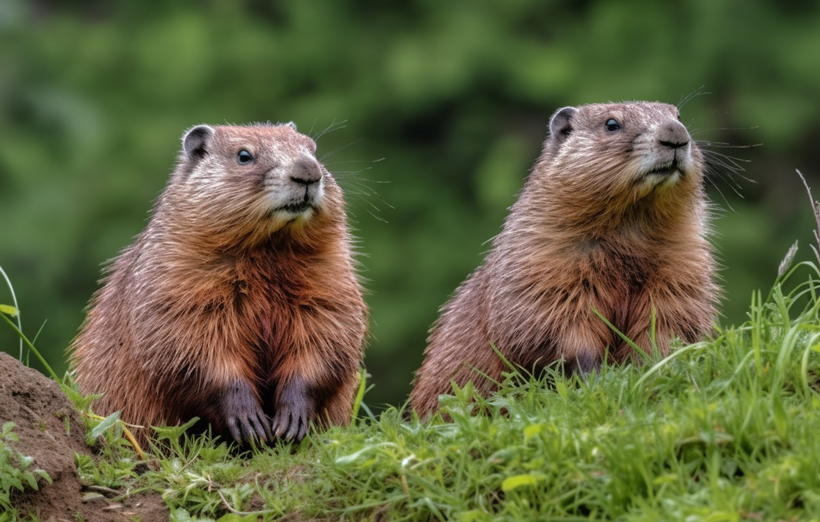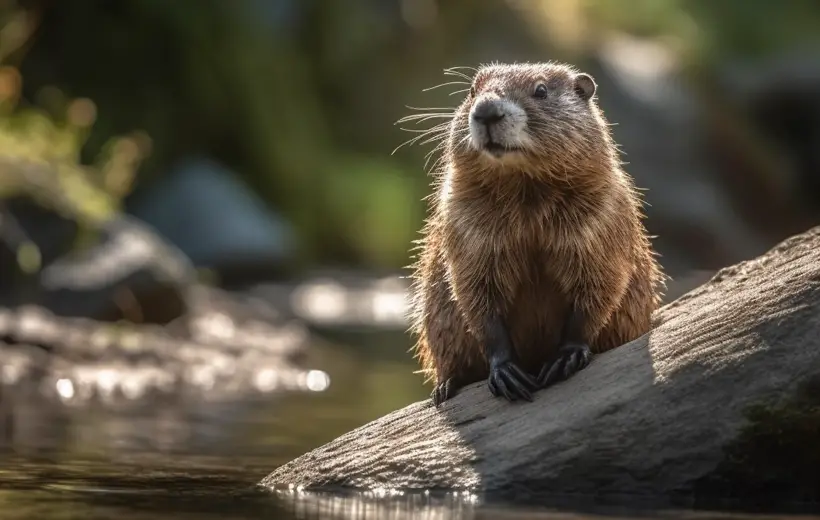Are Marmots Dangerous? Understanding Marmot Behavior and Potential Threats
Marmots are part of the squirrel family, just like groundhogs. They can weigh up to 18 pounds and grow up to 32 inches in length. The potential threats these creatures can pose to humans, regardless of their harmless appearance, should be understood.
So, are marmots dangerous? Marmots are not considered aggressive animals and typically avoid humans. However, they can become a threat in certain circumstances. When threatened, marmots can cause injury with their sharp teeth and claws. In cases where they feel threatened, they may attack humans.
Furthermore, marmots can transmit diseases to humans. Keep reading to understand and avoid these threats.
Marmot Behavior
There are no less than 15 marmot species worldwide. These furry mammals are known for their social behavior, territoriality, and distinctive vocalizations.

In this section, we will explore the behavior of marmots in different seasons, their communication patterns, mating rituals, and aggression triggers.
Territoriality and Communication
Marmots are territorial animals that establish their burrows in specific areas. They use vocalizations, scent marking, and body language to communicate and define their territory with other marmots.
These vocalizations include whistles, chirps, and barks, which are used to communicate danger, mating readiness, and territorial disputes. Marmots also use scent marking to identify their territory and attract mates.
Mating Rituals
Marmots are monogamous and mate for life. During the mating season, which usually occurs between April and May, males compete for female attention.
Male marmots engage in a variety of behaviors to attract female partners. These behaviors include chasing, fighting, and vocalizing. Male marmots may also engage in scent marking.
In scent marking, they rub their scent glands against objects in their territory. This signals their presence and advertises their availability to potential mates.

Accordingly, female marmots play an active role in mate selection. They assess males based on their physical condition, vocalizations, and behaviors. Finally, they may mate with the male who displays the most desirable traits.
Once a female chooses a mate, they will form a pair bond and engage in monogamous behavior. This may include grooming, huddling, and defending their territory together. The newborn pups show general mammal behavior.
However, female marmots tend to cheat on their mates at times due to genetic reasons.
Seasonal Behavior
During the summer, marmots are active and spend most of their time foraging for food, grooming, and socializing. They store food in their burrows for the winter when food is scarce.
And in the winter, marmots hibernate and reduce their body temperature and metabolism to conserve energy. In preparation for hibernation, marmots will also increase their food intake during the fall months. It helps them to store enough body fat to sustain them throughout the winter.

During hibernation, they will enter a state of deep sleep where their heart rate and breathing slow down significantly. They may go for weeks without food or water.
In the spring, the weather begins to warm up and food becomes more abundant. Marmots will emerge from their burrows and begin to mate and reproduce. This is also a time when they will engage in territorial behaviors, such as chasing off other marmots from their territory.
Aggression and Triggers
Are marmots aggressive? Marmots are generally not aggressive toward humans, but they can become aggressive if they feel threatened. Common triggers for marmot aggression include:
- Approaching too closely to their burrows
- Making sudden movements or loud noises
- Stumbling upon their young or food stores
- Presence of predators or other danger
If a marmot feels threatened, it may emit a high-pitched alarm call or resort to aggressive behavior, such as biting or charging. It’s important to maintain a safe distance from marmots.
Potential Threats from Marmots
In this section, we will discuss the potential dangers of marmots and marmot behavior toward humans. There will also be tips to prevent any harm caused by them.

Potential Threats from Marmots
Despite being unaggressive towards humans, there are situations where marmots can become a threat to humans. Some of the potential threats from marmots include:
- Injury: Marmots have sharp teeth and claws that can cause serious injury if they feel threatened. Marmot’s attacks towards humans can be triggered if they feel their burrows or young ones are in danger.
- Disease: Marmots can carry various diseases such as plague, hantavirus, and tularemia. These diseases can be transmitted to humans through bites or contact with their feces or urine.
- Damage to property: Marmots are known to burrow extensively, and their burrows can cause damage to properties, including foundations, roads, and sidewalks. The burrows can also undermine the structural integrity of buildings, leading to potential hazards.
- Crop damage: In areas where agriculture is prevalent, marmots can cause significant crop damage, leading to economic losses. That’s because marmots are herbivores and feed on various vegetation, including crops.
- Attracting predators: Marmots are prey for many predators, including eagles, coyotes, and foxes. When marmots inhabit an area, they can attract these predators, potentially increasing the risk of human-predator conflicts.
How to Prevent Marmot Attacks?

Here are some safety tips to prevent marmot attacks:
- Avoid feeding marmots: Do not feed marmots as it can lead to habituation and make them more aggressive towards humans. Marmots are attracted to human food and garbage and may try to access it. This can cause damage to property or harm to humans.
- Do not approach marmot burrows: Marmots are territorial and will defend their burrows if they feel threatened. Avoid approaching marmot burrows and keep children and pets away from them.
- Keep a watchful eye: While hiking or exploring wildlife habitats, keep a watchful eye for any signs of marmots or other wildlife. Be aware of your surroundings and avoid any areas where marmots are present.
- Sensible wildlife photography for wildlife safety: Be cautious when taking photographs of marmots. Do not get too close or try to touch them. Use a telephoto lens or binoculars to observe them from a safe distance.
Risks Associated with Human-Marmot Interaction
There are several risks associated with human-marmot interaction, some of which are:
- Food sharing: Sharing food with marmots can lead to habituation and dependence on human food. This can cause marmots to become aggressive and pose a threat to humans.
- Improper disposal of waste: When humans feed marmots or leave food scraps around their habitat, it can lead to a change in their natural behavior. This can encourage marmots to approach humans more frequently, which can be dangerous.
Additionally, improper disposal of waste can also lead to an increase in the population of rodents. This can lead to an increase in the transmission of diseases.
- Human-marmot conflict: Human populations are expanding and taking over natural habitats, resulting in increasingly frequent conflicts between humans and wildlife. Marmot habitat risks also increase due to this.
In some cases, marmots may be seen as pests and targeted for removal or extermination.
Marmot Safety Tips
This section will discuss how to identify marmot behavior cues that suggest aggression, safe distance, and behavior around marmots. These are part of the safety tips to ensure your hiking safety or camping safety in marmot habitats.

Identifying Marmot Behavior Cues
Marmots communicate with their body language, and it’s important to understand their behavior cues to avoid any potential danger. Here are some marmot behavior cues to look out for:
- Whistling – Marmots often whistle when they feel threatened or to alert other marmots of potential danger.
- Posture – If a marmot is standing on its hind legs, it’s a sign of aggression and means it’s ready to defend itself.
- Tail position – It’s best to keep a safe distance if a marmot’s tail is raised because it can be a sign of aggression.
- Charging – If a marmot charges at you, it’s a sign of aggression and means it feels threatened.
Safe Distance and Behavior Around Marmots
It’s important to keep a safe distance and behavior around marmots to avoid any potential danger. Here are some tips:
- Stay at least 75 feet away from marmots to safely watch them
- Keep your voice down and avoid sudden movements that could startle them
- Never approach a marmot that is exhibiting signs of aggression
- If you encounter a marmot on a trail, give it plenty of space to pass
Conclusion
In conclusion, marmots are generally peaceful and prefer to avoid human contact. However, understanding their behavior and the potential threats they pose is essential. Humans can reduce the risk of interacting with marmots by maintaining a safe distance and avoiding feeding them.
Being aware of their presence is highly necessary. Moreover, it is crucial to behave responsibly and be informed when interacting with wildlife. It not only protects us but also preserves the natural habitats of these animals.
Further research can be conducted to understand the behavior of marmots and other wildlife better. This can help us and wildlife management agencies make informed decisions when encountering them in their natural habitat.





